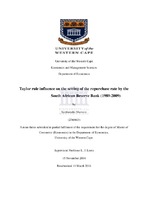Taylor rule influence on the setting of the repurchase rate by the South African Reserve Bank (1989-2009)
Abstract
Monetary policy rules are guidelines applied by policy makers when adjusting monetary instruments towards reaching policy objectives like price stability. The South African Reserve Bank (SARB) uses the repurchase (repo) rate at which it lends to commercial banks as its monetary instrument. This study examines whether the SARB considers the output gap when deciding on changes to the repo rate. In order to test the above hypothesis the study applied a simple multiple linear regression model (quantitative methods). The hypothesis was tested based on the following independent variables: consumer price index (headline), natural real interest rate, potential output and actual output using the Eviews and STAMP econometric software packages. The study focussed on the time period between 1989 and 2009 when the central bank governors were targeting the repo rate as an instrument towards achieving their monetary policy objectives. The results illustrate evidence of 82 % to 92 % correlation in the movements between the predicted Taylor rule with the univariate model and the actual repo rate. This means that the behaviour the SARB monetary policy conduct was sufficiently structured and influenced by the developments of both inflation and the output gap, even though the SARB have not consciously implemented a Taylor model. In short, the output gap and inflation rate gap pressures influenced strongly the monetary policy decisions of the SARB, even before the formal adoption of an inflation targeting framework.

